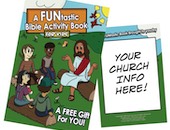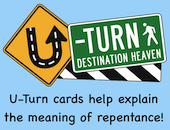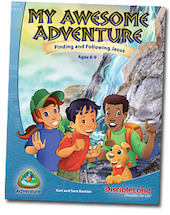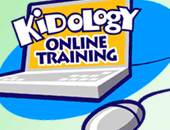How to Put Together Ready-to-go Emergency Lessons
Membership Level› Guest
Author/Source: Janelle Hoos
Topic: Leadership, Preparation, Volunteers
Have you ever had a Sunday School or Kids Church leader call in sick last minute? If you're not prepared, you'll be left scrambling for ideas for your substitute teacher. To avoid this, have an emergency lesson ready to go.

An emergency lesson is one that's prepped and ready to go for situations where a substitute is required and has no time to prepare a lesson. The sub should be able to open the envelope or small container and easily follow the lesson inside.
So, emergency lesson kits should be simple, require no preparation, include no complicated activities, and need little supplies or equipment.
These kits should fit into an envelope or small container with everything ready (unless items needed are kept in the classroom the lesson will be used in – pencils, markers, etc).
Put together one lesson kit for preschool kids and one for elementary kids.
Putting Together a Lesson for a Preschool Emergency Kit
The lesson should include a Bible story, song, game/activity/craft, and coloring sheet.
1. Choose a key theme and write it in a simple sentence. For example, "God made everything."
2. Choose a Bible story and write it out, or even better, provide a Bible story book. With a Bible story book the volunteer simply reads the story and the visuals are included. For example, tell the story of creation from Genesis chapter one.
3. Choose a simple song that the volunteer can sing acapella that reinforces the theme. Pick a song that has music familiar to the volunteer. For example, change the lyrics to "God is So Good" to
God made the day.
God made the day.
God made the day.
And He said it was good.
It’s easy to add verses changing what God made (God made the night; God made the stars, etc).
4. Choose a simple activity/game/craft that reinforces the theme. For example, set out play dough – encourage the kids to make trees, animals, whales, etc.
"You’re making a horse. God made the horses. God made everything."
5. Choose a coloring picture and photocopy enough for an average size class.
6. Gather all the supplies that will be needed. Consider what will definitely be available to the substitute volunteer in the classroom. For example, if crayons and play dough will be in the classroom, then you don’t need to include them in this kit. You will want to include a short introductory letter stating what is expected of the volunteer and what they will find in the kit (include the key theme in this note and where to find any items they will need that are stored in the classroom); clearly print out the song to sing with the tune used; if you are printing out the Bible story, format it so that it is very easy to read – big font and space between paragraphs; photocopy enough coloring pages. If identification is required in your program, include a blank nametag that the volunteer can fill out.
Putting Together a Lesson for an Elementary Emergency Kit
Each lesson should include a Bible story, game/activity/craft, and/or activity sheet.
Since the teacher will not have time to prepare the lesson, you want to give them a lesson that is Biblical and meaningful yet easy to present. I would recommend choosing a Bible story that the class can act out.
Example – Jesus Wants Us to Trust Him
Key Theme – Jesus Wants Us to Trust Him.
Hook – Ask a volunteer to come to the front. Stand behind the volunteer and ask if they trust you. Say, "I want you to trust me and fall backwards. I will catch you." After the demonstration, talk with the group about whether the volunteer demonstrated trust in you or not. Say, "Today we are going to be talking about trust. Trust is confidence in something that is true or belief in someone. Jesus wants us to trust Him."
Bible Study – Split the class into two groups. Each group is going to read a different passage of Scripture and present a skit to the other group. Give each group a passage of Scripture (Mark 2:1-12 or Mark 4:35-41) to study and 15-20 minutes to come up with a skit. Tell the kids that the skits should emphasize how the people in the story showed they trusted Jesus or showed they didn’t trust Jesus. Each group will present their skit.
Discussion – Jesus wants us to trust Him. Why is He worthy of our trust? (Because He loves us; He knows everything about us) What does trusting Jesus look like? (Obeying Jesus even when it’s hard; Choosing to do what is right; Doing the right thing even when we are scared).
Application – Is it hard to trust Jesus? Can you think of a time when you didn’t trust Jesus? What are some ways you can trust Jesus this week? Pray with the kids, encouraging them to ask God to give them an opportunity this week to show that they trust Jesus.
Activity/Game/Craft – provide copies of an activity sheet related to the memory verse. A maze or code is always fun.
Memory Verse – Trust in the Lord forever, for the Lord, the Lord, is the Rock eternal. Isaiah 26:4
Gather all the supplies necessary for this lesson. If the classroom doesn’t have a prop box, include a few props to make the skits more engaging for the students. Include the instruction sheet for the volunteer (a thank you note, the key theme, lesson outline, where to find any items stored in the classroom), index cards with one Bible passage reference written on each one, photocopies of the memory verse activity sheet.
2 Important Last Steps
1. Once you have a complete lesson in an envelope or small container, label it clearly and store it in an easy-to-access place. Find a spot to store your emergency lessons that is easy to remember for your volunteers and easy to get at when needed.
2. Let everyone know what it is and where it is. This includes your team of volunteers, all substitutes, and the pastor.












